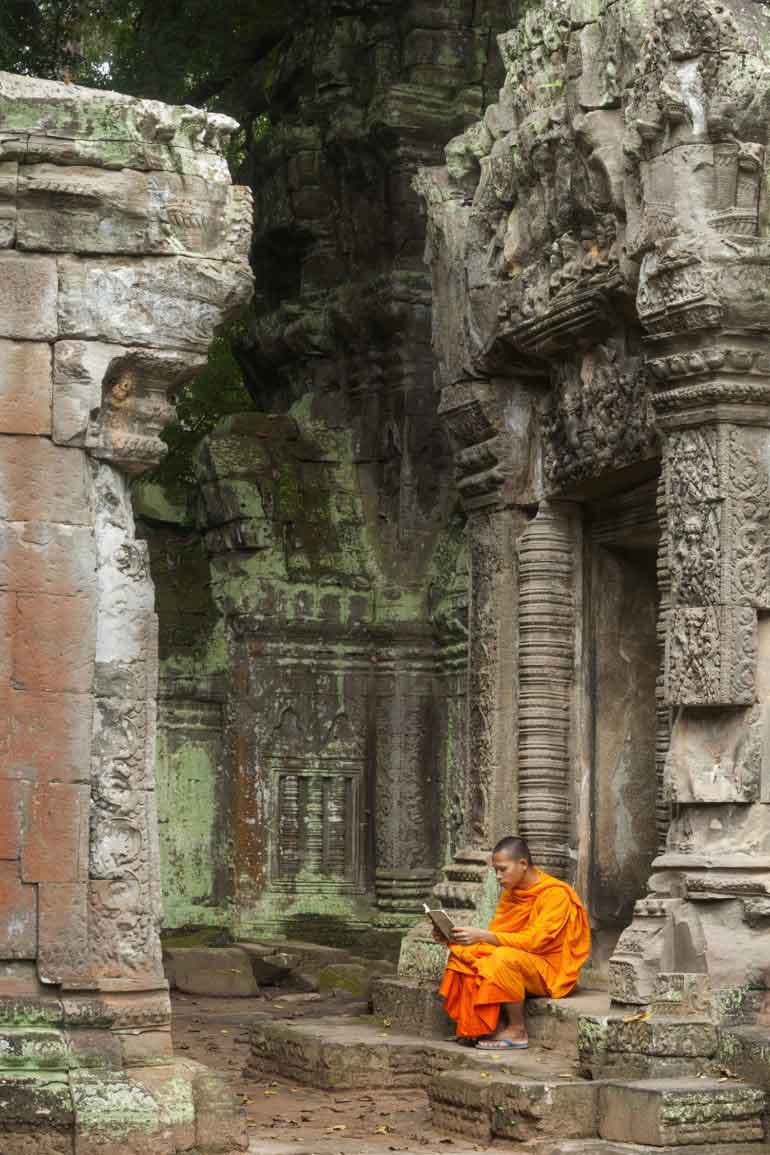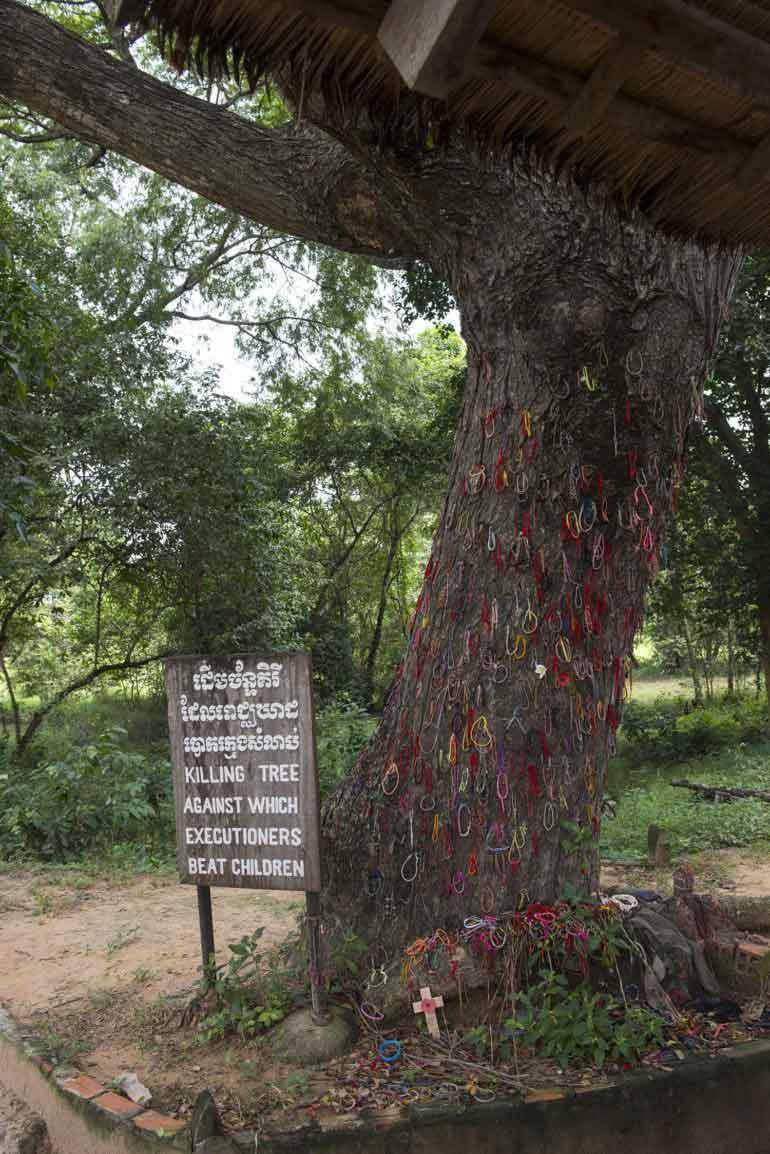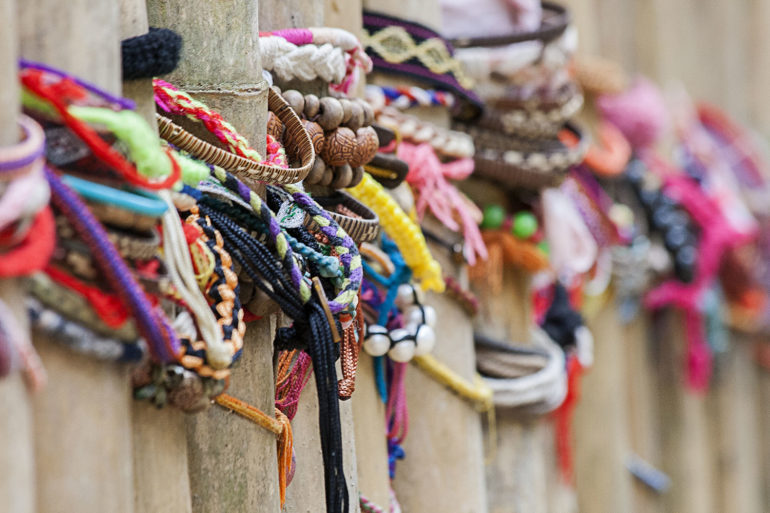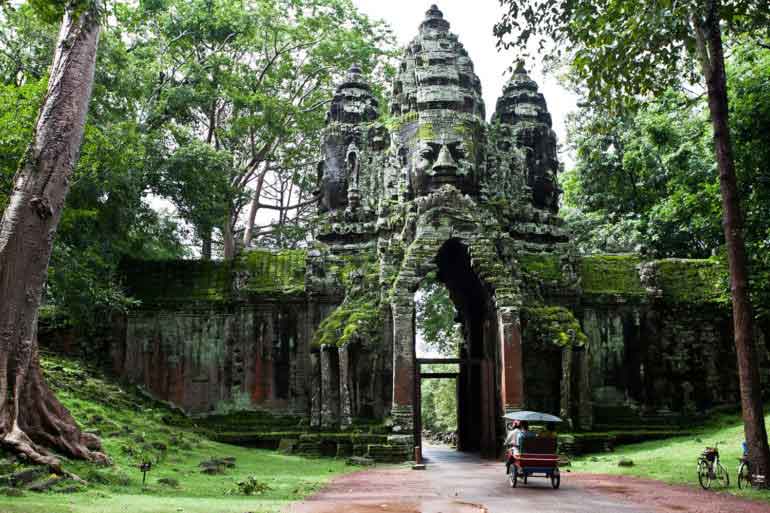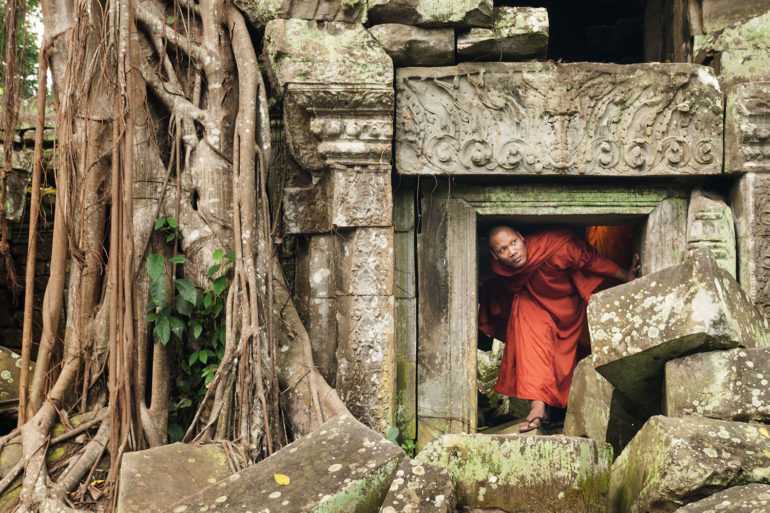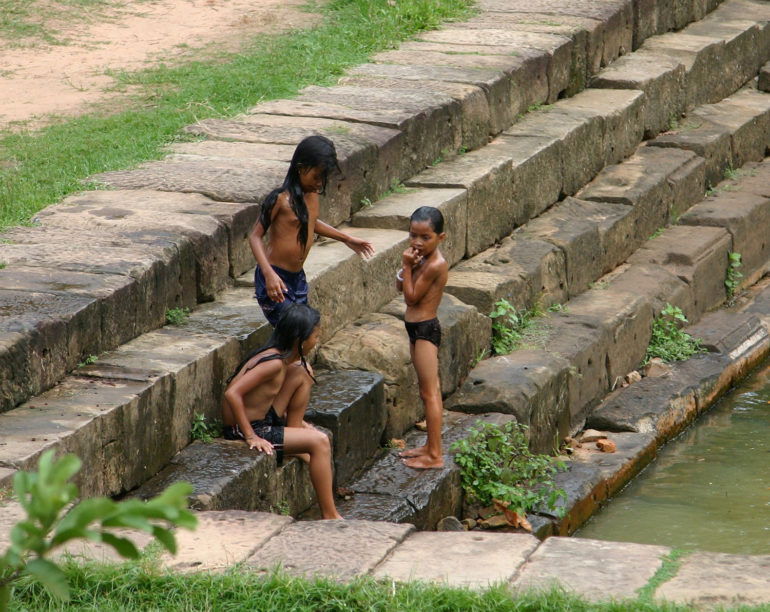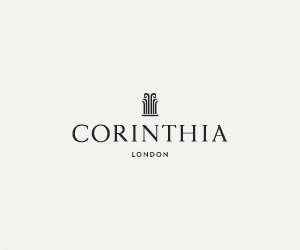Zack Cahill’s week-long taster of Cambodia reveals gruesome stories of a recent past, but also a majestic and magical ancient history.
So, this morning we will be visiting the school for street children, then the Killing Fields, then the Genocide Museum. This will be followed by a five-course lobster brunch.”
With a sentence like that, you know you’re in for some emotional whiplash. A few hours later I will burst into tears by the swimming pool while eating a twenty-dollar club sandwich. That’s Cambodia, a country of deep contrasts. The highs are high, but the lows are the lowest you’ll ever experience.
My first day in Phnom Penh passed in that hazy way where humidity, jetlag and a foreign climate combine to make everything dreamlike. A tour of the King’s Moonlight Pavilion, gold, red and pink pillars held aloft by statues of the bird-headed god Garuda; tourists in bovine herds under parasols; pregnant street dogs drinking water from a giant plant pot; Buddhist monks taking iPhone selfies, looking like an idea Banksy rejected as too on-the-nose. All this is played out to a soundtrack of constant, endless stories about gods and demons, woven with the demented dream-logic of myths – loose and improvisational.
I’m prone to temple fatigue, especially if I’m jetlagged and no one has handed me a beer, so I had turned in early, hoping to somehow prepare myself for today.
“Call me Cham,” says my guide with the smile of a man who has long ago stopped expecting white people to pronounce his full name. He leads me through a school for street children set up by a European couple in the early noughties. The kids are all around us, in clean white shirts and polished shoes, smiling and giggling and tiny. Here they learn English and a trade. More importantly they’re kept off the street and away from the dangers they’d face there.
“Education is important,” Cham stresses. “In the eighties, children had no education. They became cruel.”
I ask him what he means by cruel. He explains that the country had undergone a gigantic trauma, people were deeply scarred and it was difficult to even talk about what had happened, let alone process it. Eventually, children stopped believing the Khmer Rouge had ever existed. They started thinking of them as some kind of Boogeyman cooked up by parents to scare them into doing their chores.
“Not good,” Cham says, “because if you don’t believe, it can definitely happen again.”
This place is a soft landing, an inoculation of hope and positivity to ready us for the Killing Fields.
It’s a long and complicated political yarn, but here’s the digested version. The Khmer Rouge were an offshoot of the Communist Vietnam People’s Party. They won the Cambodian Civil War and installed their own government in 1975, led by Pol Pot. They proceeded to kill two million of their fellow Cambodian men, women and children.

This story first appeared in The Non-Stop Tel Aviv Issue, available in print and digital.
Subscribe today or purchase a back copy via our online shop.
That’s what Wikipedia will tell you. But as our van pulls out and Cham turns in his seat to tell his personal story, it’s clear I’m going to get a far more visceral version.
He was 13 when the Khmer Rouge took power. Their first act was to evict everyone from their homes and send them out of Phnom Penh on foot. Cham remembers leaving the city as defeated soldiers of the old regime walked in the opposite direction holding onto a long thread. The thread led them back into the city, to the Khmer soldiers and certain murder. The emptying-out of Phnom Penh was intended as an etch-a-sketch ending to the old way of life. Cross it out and start over – destroy class, destroy culture. Replace them with uniformity and labour and crushing dullness. Families were dragged from urban areas, suspected havens for corruption and rebellious thought, and put to work in the fields.
They divided the workforce by age. Everybody worked. Illiterate children were taken out of school and given jobs they couldn’t possibly fathom as doctors and nurses. The 16-25-year-olds who did the hardest work were given 100kg of rice per year. Everyone else got 25. Many, like Cham’s family, quickly died of starvation or malaria. Many more were sent to the Killing Fields.
The first thing I see as I step off the bus is a sunburnt tourist puking in a bush. It is 35 degrees and humid and I don’t know if the man is suffering from the heat, a hangover or from what he’s just seen. Either way, it’s an apt omen.
Cham ushers us through the gates to a low-rise wooden building, where we watch a jarringly amateur documentary, badly edited with horror movie sound effects. Watching something so shoddy in a sombre atmosphere that you absolutely can’t laugh in, is a surreal experience. It’s making me nervous. I have an appetite for dumb, violent movies, but I’m pretty sensitive to the real thing and I really have no idea how I’m going to handle all of this.
He walks us to a large, rectangular depression in the ground, with wooden walkways built around it. “They buried them in holes like this. We built the walkways because when tourists walk on the ground, bones pop up.”
Cambodians are incredibly frank people. When Cham talks about what happened, he doesn’t attempt to soften the blow in any way. There are no euphemisms or gilding the lily, but he doesn’t dramatise or get emotional either. He just baldly states the facts.
“Bullets were too expensive, so they beat people to death with heavy branches or sticks. They blindfolded them and battered them over the head. Prisoners were kept waiting in huts while the soldiers dug their graves. Speakers blared music in order to drown out screams. They covered the bodies in DDT, for the smell and to finish them off if the blows to the head hadn’t. Then they brought out the next wave of victims.”
The victims here came from the nearby S21 prison, accused of spying for the CIA, KGB or Vietnam. To be accused meant your entire family was arrested.
“That’s Cambodia. A country of deep contrasts.”
“Cut grass. Remove the root,” says Cham. “That was the saying. Even babies. No one is released. To kill by mistake is better than to release by mistake.”
We are quiet in the moment. Then he shrugs and says as if it was intended to cut the melancholy, “Ok so we go look at mass grave without head.”
We walk on to another nearly identical depression in the ground from which dozens of headless bodies were exhumed. I look up at the long path ahead of us. It’s nothing but holes like this.
The worst part is ‘the tree’. Gnarled, thick and twisted, every square inch of it today adorned with colourful bracelets and trinkets. A sign beside it, written in that same sparse, affectless language so common here, reads: “Killing tree against which executioners beat children.”
Cham leaves me to walk around and I am drawn to a tall glass monument filled to the top with drawers of bones – femurs, skulls and ribs. The bones are marked blue for male and pink for females, the closest they could come to restoring the bodies to some sort of order and dignity. Along the bottom are weapons – machetes, clubs, and heavy bamboo branches. I walk on, breathe deeply and write down everything I see.
This is just one of 400 killing fields. Around 20 thousand people were killed at this one alone. Comedian Eddie Izzard has a routine about the Killing Fields. He says that when someone commits murder, you call them a bad person. When they kill ten, you call them a psychopath. When they kill a million, you’re almost going, “Well done! Your diary must be very busy.”
I understand where that ‘joke’ comes from now, because I have been forced to consider the colossal administrative effort involved in exterminating two million people. “Well, of course, bullets were too expensive,” I say to myself. It just makes sense.
It’s the Genocide Museum that finally breaks me. S24 is where those accused of treachery were imprisoned before execution. It looks like a school or a particularly depressing council block. Grey boxes stacked geometrically round a balding square of grass. Most prisoners were kept in horrendous, dark brick boxes, barely large enough to contain one person lying flat.
Special prisoners, often ex-Khmer government officials, were kept in bigger rooms shackled by the ankle to a bare bed with a small metal box as a toilet. They were tortured here till they named someone as a spy. Then that person and their whole family were killed. The air feels heavy, suffused with its horrible secrets. I feel dizzy and nauseous.
I wonder about all the pointless and elaborate administration at play here. Was there a genuine belief that they were spies? Was the regime really that paranoid? Or was it all just a cynical attempt to add a layer of authenticity to their regime? It’s all so needlessly cruel.
Regimes thrive on paranoia; the ‘us versus them’ mentality it engenders makes soldiers crueller, makes them hate much harder, torture more terribly; all supposedly to prove their loyalty. That’s how dictators make people do this stuff: keep them terrified, create a Panopticon in which you are constantly at risk of being frowned upon. Then you become the prisoner.
At the end of the tour, we walk into a room full of paintings by a man called Vannat – one of only seven people who miraculously survived the camp – depicting everything that went on here. The paintings are absolutely shocking, the action presented so starkly, almost diagrammatic. A woman is strapped naked to a table. One man squats over her tearing at her breast with a pair of pliers. Another soldier stands by, holding a huge squirming centipede in tweezers. The last painting shows a soldier smashing a baby against a tree – the tree – while its mother is brutally dragged away.
I have to walk out of the room, taking deep breaths and turning the corner, I run straight into another survivor – a tiny old man with no teeth, selling a book about his experience here, which he’ll sign for you.
Afterwards, we have a decadent brunch of flambéed lobster and champagne and I think I’m ok. I go sit by the pool of the hotel. They print out an Irish Times for me, so I can read about ghost estates in Navan, and suddenly without warning, I burst into inconsolable tears.
The next day, we drive nine hours to Siem Reap with our new guide, Sita, a dwarfish, animated man with a sly sense of humour and a stable of weird phrases. “We stop at Spider Town, to use happy room!” he yells over his shoulder. Happy room means toilet.
“Spider Town?” I ask. He bursts out laughing, “Sorry, wrong name, wrong name,” he says, waving his hands, “it’s called Tarantula Town.”
Sure enough Tarantula Town is a small roadside market boasting a ‘Love-craftian’ array of bug-eyed horrors – crickets, water beetles and stuffed frogs – glistening piles of spiny legs and armoured torsos and bulging eyeballs. Cheap protein sold by the can. And in case you were wondering, yes I did. They taste like nuts.
Sita is right to bring us to the Happy Room here. If you were to eschew his advice in Siem Reap and wander off into the forest to relieve yourself, you could lose a limb. Two million tonnes of unexploded ordnance still lies buried in these towns and mines still kill three people a month. Metal detectors can’t pick up anti-tank mines so most of them are still out there. Sita’s brother lost a leg fighting the Khmer Rouge. Though Sita assures me his brother still found a wife. “He lose the leg fighting for her country, so she look at him she sees two legs.”
Siem Reap is heaving with temples, but the big two are the sprawling Angkor Wat, the largest religious temple in the world, and Angkor Thom, the ‘Jungle Temple’, made famous by the Tomb Raider film which effectively launched the tourist industry here.
As we approach Angkor Thom via Sita’s secret route, he yells at me to be careful of mines. I’m not sure how I’m supposed to do that, so I just pray he’s being dramatic. We thread between bullet-riddled columns under the eyes of ancient Hindu demons. The constant (unfounded) fear of death by unexploded landmine is worth it, because when the foliage falls away we are afforded a rare unobstructed view of the spectacular ancient temple.
If you’ve ever wondered what our cities will look like after the human race wipes itself out, Angkor Thom is your best clue. A thousand years ago this was the capital of the Khmer empire, a fortified city for priests, military and royalty. Now nature has reclaimed it. Every structure exists in symbiosis with enormous, ancient trees growing under, around and through it – simultaneously erupting through walls and holding them together. Vines spill over arched stone doorways. Enormous stone Buddhas split apart as green shoots wriggle through the cracks.
Sita is an enrapturing, animated guide. Tell a Cambodian you like something – a bridge, a temple – they will always say thank you. It sounds like a small thing, but that doesn’t happen when you tell a Brit you like Buckingham Palace or praise the Grand Canyon to an American. They may recognise the beauty of the monument, but won’t feel the same personal pride. It’s a difference of ownership.
“Through here is a statue of Garuda, the animal form of Shiva,” he says, leading me through collapsing corridors, up uneven steps. “Along here are carvings of the ancient way of life, see them practicing with swords and shields? And through here…” he points to a dark, mysterious doorway. “Look through to the other side. I only discovered this three years ago.” I lean in, peering into the darkness. “There’s a tree that looks like a human butt.”
Some famous places crumble beneath the weight of expectation. Angkor Wat doesn’t. You can read about it and look at pictures, but when you see it for yourself you will be struck silent. A 400-acre city rising in layers toward a central mountain-temple; earthy colours; barnacled and filigreed with elaborate flourishes on every surface.
A bas-relief sculpture runs the entire length of one level depicting an epic battle between gods and demons. I imagine children back then poring over it, relishing the crazy tale like a 12th-century version of Star Wars.
Like the pyramids of Egypt, all sorts of ancient cosmic mathematics are baked into this structure. It aligns along an axis with the temples at Giza and Machu Picchu. Why? We don’t know. Some of the more out-there historians, the controversial Graham Hancock in particular, claim the temple is a representation of the constellation Draco and is evidence of advanced, even alien wisdom.
I don’t buy that. But this is a place of great and undeniable power. A measure of any great historic site is whether you can tune out the noise; ignore the sunburnt tourists balling at each other, milling about with selfie-sticks, and have a moment of peace. I find a quiet corner and do just that. I sit and breathe the same air King Suryavarman II breathed a thousand years ago in this stunning, monolithic palace.
Being here in Siem Reap, I conclude that Cambodia is worth the lows. Because they aren’t really lows so much stress-tests for empathy. You will be better for knowing them. You will emerge hopeful, maybe kinder, certainly grateful. That’s what happened for the Cambodians.
Zack’s journey through Cambodia was courtesy of Inspiring Travel Company, who offer a six-night ‘Essential Cambodia’ trip with three nights each, fully guided, in Phnom Penh and Siem Reap. Excursions aside, Inspiring Travel Company will help you get local, with cooking classes, dinner with a local family and traditional Khmer massage.
Photography by Alfio Manciagli
Get out there
Do…
… travel with a local guide. This way you’ll get a first-hand experience of what it was really like to live under the Khmer Rouge.
… take the time to digest what happened in this otherwise beautiful country. It’s overwhelming but eye-opening.
… rise early to watch the sunrise over Angkor Wat. It’s not so much a best-kept secret anymore, but nevertheless still amazing.
Don’t…
… forget to explore the modern cities of Phnom Penh and Siem Reap. While your journey here will inevitably be filled with history lessons, today’s Cambodian cities hold a number of amazing, contemporary delights and act as a beacon of hope for a Cambodia of the future.
… feel like you need to see the complex of Angkor all at once. Firstly, it is impossible – at time of press, new parts of the city are being discovered – so leave some for the following day or another trip.
The inside track
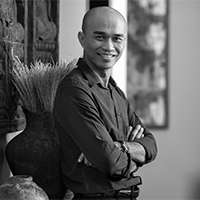
Cambodian hospitality trailblazer Soann Kann is a young, entrepreneurial local who is revolutionising the Siem Reap boutique scene with his popular spas, hotels and restaurants, Chanrey Tree.
Caffeinate
For the best coffee in Siem Reap, head down to the hip local hangout of Hap Guan Street, to Little Red Fox Espresso. It’s a hair salon and bean press, but the coiffure and coffee are as good as each other.
Drink
For LGBTQ+ travellers, there are a number of bars worth noting. Linga has been in business for nearly 15 years and is the stalwart, but also try Miss Wong and Barcode Siem Reap. You’ll be surprised that a small city has such a scene.
Treat
My Sokkhak Spa provides traditional Khmer massage with therapists hailing from a specific village in the ‘Pourk District,’ who are the very best.


